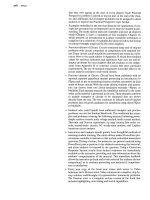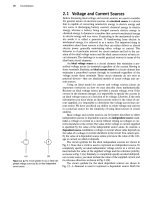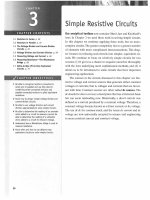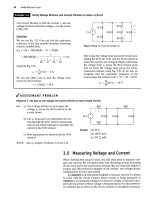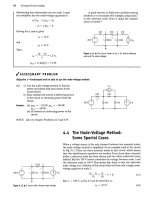Electric Circuits, 9th Edition P16 potx
Bạn đang xem bản rút gọn của tài liệu. Xem và tải ngay bản đầy đủ của tài liệu tại đây (269.58 KB, 10 trang )
126 Techniques of Circuit Analysis
dv
2 =
R
3
R
4
{R
y
R,I,
2
- [R
2
(R
3
+ R
4
) + R
3
R
4
]I
gl
}
dR,
" [(R
l
+ R
2
)(R
3
+ R
4
) + R
3
R
4
]
2
(4.98)
Figure 4.69 A Circuit
used
to introduce sensitivity
analysis.
We now consider an example with actual component values to illustrate
the use of
Eqs.
4.97 and 4.98.
EXAMPLE
Assume the nominal values of the components in the circuit in Fig. 4.69 are:
R
l
= 25 H; R
2
= 5 ft; R
3
= 50 ft; R
4
= 75 ft; I
g]
= 12 A and
I
g2
= 16 A. Use sensitivity analysis to predict the values of v
x
and v
2
if
the value of R^ is different by 10% from its nominal value.
Solution
From Eqs. 4.95 and 4.96 we find the nominal values of v
v
and v
2
. Thus
25(3750(16) - [5(125) + 3750112}
and
30(125) + 3750
3750[30(16) - 25(12)]
v
2
= . = 90 V
30(125) + 3750
(4.100)
Now from Eqs. 4.97 and 4.98 we can find the sensitivity of V\ and v
2
to
changes in R
t
. Hence
dv
{
[3750 + 5(125)] - (3750(16) - [3750 + 5(125)]12}
dRi
[(30)(125) + 3750]'
12 '
(4.101)
and
dv
2
_ 3750(3750(16) - [5(125) + 3750J12}]
tf/c7 " (7500)
2
= 0.5 V/a
(4.102)
How do we use the results given by Eqs. 4.101 and 4.102? Assume that
Ri is 10% less than its nominal value, that is, R\ — 22.5 ft. Then
Ai?!
= -2.5 ft and Eq. 4.101 predicts Av
x
will be
Av
i
=
(^V
2
-
5
)
=
-1-4583
V.
Therefore, if R^ is 10% less than its nominal value, our analysis predicts
that v\ will be
Vi. = 25 -
1.4583
= 23.5417 V. (4.103)
Similarly for Eq. 4.102 we have
Av
2
= 0.5(-2.5) = -1.25 V,
v
2
= 90 - 1.25 = 88.75 V. (4.104)
We attempt to confirm the results in Eqs. 4.103 and 4.104 by substituting
the value R^ = 22.5 ft into Eqs. 4.95 and 4.96. When we do, the results are
v
x
= 23.4780 V, (4.105)
v
2
= 88.6960 V. (4.106)
Why is there a difference between the values predicted from the sensitivity
analysis and the exact values computed by substituting for R^ in the equa-
tions for V\ and v
2
l We can see from Eqs. 4.97 and 4.98 that the sensitivity
of Vi and v
2
with respect to R^ is a function of R
lt
because R^ appears in
the denominator of both Eqs. 4.97 and 4.98. This means that as Ri
changes, the sensitivities change and hence we cannot expect Eqs. 4.97 and
4.98 to give exact results for large changes in /¾. Note that for a 10%
change in R
u
the percent error between the predicted and exact values of
v
x
and v
2
is small. Specifically, the percent error in v
{
= 0.2713% and the
percent error in v
2
= 0.0676%.
From this example, we can see that a tremendous amount of work is
involved if we are to determine the sensitivity of v^ and v
2
to changes in
the remaining component values, namely R
2f
R
3t
R
4f
I
gU
and I
g2
.
Fortunately, PSpice has a sensitivity function that will perform sensitivity
analysis for us. The sensitivity function in PSpice calculates two types of
sensitivity. The first is known as the one-unit sensitivity, and the second
is known as the 1% sensitivity. In the example circuit, a one-unit change
in a resistor would change its value by 1 ft and a one-unit change in a
current source would change its value by 1 A. In contrast, 1% sensitiv-
ity analysis determines the effect of changing resistors or sources by
1%
of their nominal values.
The result of PSpice sensitivity analysis of the circuit in Fig. 4.69 is
shown in Table 4.2. Because we are analyzing a linear circuit, we can use
superposition to predict values of v\ and v
2
if more than one component's
value changes. For example, let us assume /?, decreases to 24 ft and R
2
decreases to 4 ft. From Table 4.2 we can combine the unit sensitivity of V\
to changes in R
{
and R
2
to get
Auj Av\
A#[
+
1R~
2
= 0.5833 - 5.417 =
-4.8337 V/ft,
Techniques of Circuit Analysis
Similarly,
At?? Av
2
+
AS,
' AR
2
0.5+ 6.5 = 7.0 V/a.
Thus if both R
{
and R
2
decreased by 1II we would predict
Vi = 25 + 4.8227 = 29.8337 V,
v
2
= 90 - 7 = 83 V.
TABLE 4.2 PSpice Sensitivity Analysis Results
Element Element
Name Value
Element!
Sensitivity
(Volts/Unit)
(a)
DC
Sensitivities of
Node
Voltage VI
Rl 25
R2 5
R3 50
R4 75
IG1 12
IG2 16
(b) Sensitivities of Output V2
Rl 25
R2 5
R3 50
R4 75
IG1 12
IG2 16
0.5833
-5.417
0.45
0.2
-14.58
12.5
0.5
6.5
0.54
0.24
-12.5
15
Normalized Sensitivity
(Volts/Percent)
0.1458
-0.2708
0.225
0.15
-1.75
2
0.125
0.325
0.27
0.18
-1.5
2.4
If we substitute R
{
= 24 fl and R
2
= 4 ft into Eqs. 4.95 and 4.96 we get
vi = 29.793 V,
v
2
= 82.759 V.
In both cases our predictions are within a fraction of a volt of the actual node
voltage values.
Circuit designers use the results of sensitivity analysis to determine
which component value variation has the greatest impact on the output of
the circuit. As we can see from the PSpice sensitivity analysis in Table 4.2,
the node voltages Dj and v
2
are much more sensitive to changes in R
2
than
to changes in R
u
Specifically, V\ is (5.417/0.5833) or approximately
9 times more sensitive to changes in R
2
than to changes in R
x
and v
2
is
(6.5/0.5) or 13 times more sensitive to changes in R
2
than to changes in
Ri, Hence in the example circuit, the tolerance on R
2
must be more
strin-
gent than the tolerance on R^ if it is important to keep V\ and v
2
close to
their nominal values.
NOTE:
Assess
your understanding of this Practical Perspective by trying Chapter
Problems 4.105-4.107.
Summary 129
Summary
• For the topics in this chapter, mastery of some basic terms,
and the concepts they represent, is necessary. Those terms
are node, essential node, path, branch, essential branch,
mesh, and planar circuit. Table 4.1 provides definitions
and examples of these terms. (See page 91.)
• Two new circuit analysis techniques were introduced in
this chapter:
• The node-voltage method works with both planar
and nonplanar circuits. A reference node is chosen
from among the essential nodes. Voltage variables
are assigned at the remaining essential nodes, and
Kirchhoff s current law is used to write one equation
per voltage variable. The number of equations is
n
e
—
1, where n
e
is the number of essential nodes.
(See page 93.)
• The mesh-current method works only with planar
circuits. Mesh currents are assigned to each mesh,
and Kirchhoff's voltage law is used to write one
equation per mesh. The number of equations is
b — (n
—
1), where b is the number of branches in
which the current is unknown, and n is the number of
nodes.
The mesh currents are used to find the branch
currents. (See page 99.)
• Several new circuit simplification techniques were
introduced in this chapter:
• Source transformations allow us to exchange a volt-
age source (v
s
) and a series resistor (R) for a current
source (i
s
) and a parallel resistor (R) and vice versa.
The combinations must be equivalent in terms of
their terminal voltage and current. Terminal equiva-
lence holds provided that
s
R
(See page 109.)
• Thevenin equivalents and Norton equivalents allow
us to simplify a circuit comprised of sources and resis-
tors into an equivalent circuit consisting of a voltage
source and a series resistor (Thevenin) or a current
source and a parallel resistor (Norton). The simplified
circuit and the original circuit must be equivalent in
terms of their terminal voltage and current. Thus
keep in mind that (1) the Thevenin voltage (Kiii) is
the open-circuit voltage across the terminals of the
original circuit, (2) the Thevenin resistance (i?
T
h) is
the ratio of the Thevenin voltage to the short-circuit
current across the terminals of the original circuit;
and (3) the Norton equivalent is obtained by per-
forming a source transformation on a Thevenin
equivalent. (See page 113.)
• Maximum power transfer is a technique for calculating
the maximum value of p that can be delivered to a load,
R
L
.
Maximum power transfer occurs when Ri = Rjh,
the Thevenin resistance as seen from the resistor R
L
.
The equation for the maximum power transferred is
(See page 120.)
• In a circuit with multiple independent sources,
superposition allows us to activate one source at a time
and sum the resulting voltages and currents to deter-
mine the voltages and currents that exist when all inde-
pendent sources are active. Dependent sources are
never deactivated when applying superposition. (See
page 122.)
130 Techniques of Circuit Analysis
Problems
Section 4.1
4.1 For the circuit shown in Fig.
P4.1,
state the numerical
value of the number of (a) branches, (b) branches
where the current is unknown, (c) essential branches,
(d) essential branches where the current is unknown,
(e) nodes, (f) essential nodes, and (g) meshes.
Figure P4.1
4.4 Assume the current i
g
in the circuit in Fig. P4.4 is
known. The resistors R^ - R
5
are also known.
a) How many unknown currents are there?
b) How many independent equations can be writ-
ten using Kirchhoff s current law (KCL)?
c) Write an independent set of KCL equations.
d) How many independent equations can be
derived from Kirchhoff s voltage law (KVL)?
e) Write a set of independent KVL equations.
Figure P4.4
V L
4.2 a) If only the essential nodes and branches are
identified in the circuit in Fig. P4.1, how many
simultaneous equations are needed to describe
the circuit?
b) How many of these equations can be derived
using Kirchhoff s current law?
c) How many must be derived using Kirchhoffs
voltage law?
d) What two meshes should be avoided in applying
the voltage law?
4.3 a) How many separate parts does the circuit in
Fig. P4.3 have?
b) How many nodes?
c) How many branches are there?
d) Assume that the lower node in each part of the
circuit is joined by a single conductor. Repeat
the calculations in (a)-(c).
Figure P4.3
4.5 A current leaving a node is defined as positive.
a) Sum the currents at each node in the circuit
shown in Fig. P4.4.
b) Show that any one of the equations in (a) can be
derived from the remaining three equations.
Section 4.2
4.6 Use the node-voltage method to find Uj and v
2
in
PSPICE
the
circuit
in Fig. P4.6.
Figure P4.6
144 V
son
4.7 Use the node-voltage method to find how much
PSPICE power the 2 A source extracts from the circuit in
HULTISIM pjg p4J
Figure P4.7
2AI
so a
45 V
Problems 131
4.8 Use the node-voltage method to find v
x
and v
2
in
PSPICE the circuit shown in Fig. P4.8.
MULTISIM
Figure P4.8
8ft
-VvV-
<>i|40ft kmVL u
2
f 120ft C\ J1A
4.9 Use the node-voltage method to find v
()
in the cir-
PSPICE cuit in Fig. P4.9.
Figure P4.9
2011
24 V
8012
-A^
m
40
mA
4.10 a) Find the power developed by the 40 mA current
PSPKE
source in the circuit in Fig. P4.9.
b) Find the power developed by the 24 V voltage
source in the circuit in Fig. P4.9.
c) Verify that the total power developed equals the
total power dissipated.
4.11 A 50 O resistor is connected in series with the
PSPICE
40 mA current source in the circuit in Fig. P4.9.
MULTISIM
N
^,. .
a) Find v
a
.
b) Find the power developed by the 40 mA current
source.
c) Find the power developed by the 24 V voltage
source.
d) Verify that the total power developed equals the
total power dissipated.
e) What effect will any finite resistance connected
in series with the 40 mA current source have on
the value of v
a
l
4.12 The circuit shown in Fig. P4.12 is a dc model of a
PSPICE residential power distribution circuit.
a) Use the node-voltage method to find the branch
currents i
{
—
/
6
.
b) Test your solution for the branch currents by
showing that the total power dissipated equals
the total power developed.
Figure P4.12
125
V
125 V
':,
4.13 a) Use the node-voltage method to find the
PSPKE
branch currents /
a
- /
e
in the circuit shown in
MULTISIM
Fi
g.p4
>13
.
b) Find the total power developed in the circuit.
Figure P4.13
128
V
320 V
4.14 Use the node-voltage method to find the total power
PSPICE dissipated in the circuit in
Fig.
P4.14.
MULTISIM
Figure P4.14
40 V
132 Techniques of Circuit Analysis
4.15 a) Use the node-voltage method to find v
h
v
2
, and
!™.
v
3
in the circuit in Fig. P4.15.
MULTISIM
b) How much power does the 40 V voltage source
deliver to the circuit?
Figure P4.15
40 V
4.16 a) Use the node-voltage method to show that the
PSPICE
output voltage v
0
in the circuit in Fig. P4.16 is
equal to the average value of the source voltages.
b) Find v
0
if v
{
= 100 V, v
2
= 80 V, and
v
3
= -60 V.
Figure P4.16
4.19 Use the node-voltage method to calculate the
PSPICE power delivered by the dependent voltage source in
WLTISIM ., . ^. „,
n
the circuit in Fig. P4.19.
Figure P4.19
160 V
ion
3011
('„ I
loo
a
150
L
20 a
^vw-
Section 4.3
4.17 a) Use the node-voltage method to find the total
power developed in the circuit in Fig. P4.17.
MULTISIM
b) Check your answer by finding the total power
absorbed in the circuit.
Figure P4.17
84/
A
PSPICE
MULTISIM
4.18 a) Use the node-voltage method to find v„ in the
circuit in Fig. P4.18.
b) Find the power absorbed by the dependent source.
c) Find the total power developed by the independ-
ent sources.
Figure P4.18
20
a
3A
80 V
4.20 a) Find the node voltages V\, «2, and v$ in the cir-
PSPICE
cu
it in Fig. P4.20.
•IULTISIM
b) Find the total power dissipated in the circuit.
Figure P4.20
5 n
10
a
m VA f VvV-
f\5/
(
,
iv*20ft y
2
?40O yyk (^/)
96 V
Section 4.4
4.21 Use the node-voltage method to find i
0
in the cir-
PSPICE cuit in Fig.
P4.21.
MULTISIM
Figure P4.21
2kft 5kft
20
V
6
30kll lkft
PSPICE
MULTISIM
4.22 a) Use the node-voltage method to find the
branch currents ij, i
2
, and /3 in the circuit in
Fig. P4.22.
b) Check your solution for ij, i
2
, and i
3
by showing
that the power dissipated in the circuit equals
the power developed.
Figure P4.22
30 V
80 V
Problems
133
4.23
a) Use the
node-voltage method
to
find
the
power
dissipated
in the 2 (2
resistor
in the
circuit
in
Fig.
P4.23.
b) Find
the
power supplied
by the
230
V
source.
Figure P4.23
230
v
C-y
in
in
in:
la-
in
l
n
in
sn
2n
:5
n
4.24 Use
the
node-voltage method
to
find the value
of v
0
KM
«
in the
circuit
in
Fig. P4.24.
MUITISIM
Figure P4.26
25
V
55
n
4.27
Use the
node-voltage method
to
find
v
0
in the cir-
PSPICE
cuit
in
Fig. P4.27.
MULTISIM
Figure P4.27
15
V
Figure P4.24
50
V
4.25
Use the
node-voltage method
to
find
the
value
of v
a
PSPICE
in the circuit in Fig. P4.25.
«!ULTISIM
Figure P4.25
4.26
a) Use the
node-voltage method
to
find
v
0
and
PSPICE
the
power delivered
by the 2 A
current source
in
the
circuit
in Fig.
P4.26.
Use
node
a as the
reference node.
b) Repeat part
(a), but use
node
b as the
refer-
ence node.
c) Compare
the
choice
of
reference node
in (a)
and (b). Which
is
better,
and
why?
4.28 Use the node-voltage method to find the power devel-
oped by
the
20
V
source
in
the circuit
in
Fig. P4.28.
PSPICE
MULTISIM
Figure P4.28
80n (1)3.125
v
A
4.29 Assume
you are a
project engineer
and one of
your
PSPICE
MULTISIM
staff
is
assigned
to
analyze
the
circuit shown
in
Fig. P4.29.
The
reference node
and
node numbers
given
on the
figure were assigned
by the
analyst.
Her solution gives
the
values
of v
3
and v
4
as
108
V
and 81.6
V,
respectively.
Test these values
by
checking
the
total power
developed
in the
circuit against
the
total power dis-
sipated.
Do you
agree with
the
solution submitted
by
the
analyst?
Figure P4.29
20
n
1)1.75¾
134 Techniques of Circuit Analysis
4.30 Show that when Eqs. 4.16,4.17, and 4.19 are solved
for i
B
, the result is identical to Eq. 2.25.
Section 4.5
4.31 Solve Problem 4.12 using the mesh-current method.
4.32 Solve Problem 4.13 using the mesh-current method.
4.33 a) Use the mesh-current method to find the branch
currents L, //„ and L in the circuit in Fig.
P4.33.
MULTISIM
b
b) Repeat (a) if the polarity of the 60 V source is
reversed.
Figure P4.33
60
V
to
a
20
V
4.34 a) Use the mesh-current method to find the total
power developed in the circuit in Fig. P4.34.
MULTISIM
b) Check your answer by showing that the total
power developed equals the total power
dissipated.
Figure P4.34
460
V
4.35 Solve Problem 4.21 using the mesh-current method.
4.36 Solve Problem 4.23 using the mesh-current method.
Section 4.6
4.37 a) Use the mesh-current method to find v
0
in the
PSPICE
circuit in Fig. P4.37.
MULTISIM
b) Find the power delivered by the dependent source.
Figure P4.37
io
a
7
a
4.38 Use the mesh-current method to find the power dissi-
PSPICE
pate(
j in the 20 fl resistor in the circuit in Fig. P4.38.
MULTISIM
Figure P4.38
5 0
3
a
•AW
135
V
©
4ft
20
a
10
i.
2
a
la
-"VW
4.39 Use the mesh-current method to find the power
delivered by the dependent voltage source in the
JLTISIM
circuit seen in Fig. P4.39.
Figure P4.39
660 V
25 a
20 /,,
4.40 Use the mesh-current method to find the power
>SPICE
developed in the dependent voltage source in the
JLTISIM . . _. _ . ._
circuit in Fig. P4.40.
Figure P4.40
30
V
Section 4.7
4.41 Solve Problem 4.8 using the mesh-current method.
4.42 a) Use the mesh-currcnt method to find how much
power the 4 A current source delivers to the cir-
cuit in Fig. P4.42.
b) Find the total power delivered to the circuit.
c) Check your calculations by showing that the
total power developed in the circuit equals the
total power dissipated
Problems 135
Figure P4.42
120
V
5 0
80 V
4.43 Solve Problem 4.20 using the mesh-current method.
4.44 a) Use the mesh-current method to solve for i± in
PSPICE
the circuit in Fig. P4.44.
MULTISIM
b) Find the power delivered by the independent
current source.
c) Find the power delivered by the dependent volt-
age source.
4.47 Solve Problem 4.22 using the mesh-current method.
4.48 Use the mesh-current method to find the total
PSPICE power dissipated in the circuit in Fig. P4.48.
MULTISIM
Figure P4.48
20
V
90 V
4.49 a) Assume the 20 V source in the circuit in
Fig. P4.48 is changed to 60 V. Find the total
power dissipated in the circuit.
b) Repeat (a) if the 6 A current source is replaced
by a short circuit.
c) Explain why the answers to (a) and (b) are
the same.
Figure P4.44
ikn
150
k
4.45 Use the mesh-current method to find the total power
PSPICE
developed in the circuit in Fig. P4.45.
MULTISIM
Figure P4.45
20
A
6.5 /
A
4.46 a) Use the mesh-current method to determine
PSPICE
which sources in the circuit in Fig. P4.46 are gen-
IULTISIM
crating power.
b) Find the total power dissipated in the circuit.
Figure P4.46
2ft
4.50 a) Find the branch currents /
a
- i
c
for the circuit
nna
shown in Fig. P4.50.
MULTISIM
b) Check your answers by showing that the total
power generated equals the total power
dissipated.
Figure P4.50
4/
d
-i
c
19
A
4.51 a) Use the mesh-current method to find the branch
PSPICE
MULTISIM
currents in i
a
— i
e
in the circuit in Fig.
P4.51.
b) Check your solution by showing that the total
power developed in the circuit equals the total
power dissipated.
Figure P4.51
100ft



